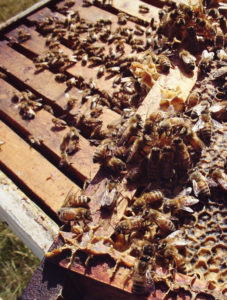“Is Your Honey Organic?”
The short answer is “yes & no”. We only use organic treatments on our bees with the goal of making sure our bees are healthy while keeping our honey free from chemical residues, but we are not certified organic.
 “Why aren’t you certified?”
“Why aren’t you certified?”
The Organic standard for honey in Canada is concerned with two main sources of chemical contamination: apicultural contaminants and environmental contaminants. (1)
1. Apicultural contaminants: Chemicals used by the beekeeper to control pests and diseases.
Honeybees are susceptible to a variety of pests and diseases which may require a beekeepers intervention to maintain colony health. There are a variety of synthetic acaricides (pesticides that target mites), organic acaricides, antibiotics, and chemical repellents that can be used for these purposes. Though all of these treatments are legal in Ontario, many countries do not allow beekeepers to use antibiotics or certain chemical repellents out of concern for their impact on human and honeybee health.
Meeting the Organic Requirement: For the organic beekeeper the first line of defense against honeybee pests and diseases is prevention through “cultural” controls: selectively breeding for resistant bees, sterilizing tools, avoiding swapping equipment between colonies or bee yards, regularly inspecting hives, and using specialized hive components that can discourage pests.
When treatments are necessary various naturally occurring compounds are available:
1. Formic Acid – Naturally occurs in honey. Responsible for the stinging sensation caused by ant bites and stinging nettle. Use of formic acid as a treatment leaves no residues in honey above naturally occurring levels.
2. Oxalic acid – Naturally occurs in honey. Also found in sorrel, rhubarb, broccoli, cabbage, spinach, and many other plants as a defense against herbivores. Use of oxalic acid as a treatment leaves no residues in honey above naturally occurring levels.
3. Botanical oils – Naturally occurring oils in aromatic plants such thyme, lemongrass, and wintergreen as a defense against herbivores and microbial infection. If not used properly these can leave residues in honey, which affect its flavour, but are not dangerous to consume.
2. Environmental Contaminants: Chemicals found in the wider environment that are brought back to the hive by foraging bees.
Honeybees regularly fly up to several kilometers from their hive to collect water, nectar, pollen, and plant resins. If the environment is contaminated by agricultural pesticides, heavy metals, or other pollutants, these compounds can be brought back to the hive by the bees and potentially end up in the honey (more on that later!).
Meeting the Organic Requirement: Organic apiaries must be surrounded by a 3km radius of organic land, i.e. land that is free from conventional agriculture, industrial sites, golf courses, residences that may use pesticides on their lawns or gardens, etc. This 3km radius amounts to 7000 acres of organic land, which is very difficult to find anywhere in southern Ontario.
Unfortunately, there is nowhere in the Ottawa area where we can keep our hives that would meet this requirement.
We Use
- Botanical oils (Thyme oil)
- Cultural controls
- Organic acids (formic acid, oxalic acid)
We NEVER Use
- Synthetic Acaricides (Amitraz, Fluvalinate, Coumophos)
- Antibiotics (Oxytetracycline, Tylosin, Fumagillin)
- Moth repellents (Para-dichlorobenzene)
- Bee Repellants (butyric anhydride)
“Why bother with Organic treatments if you aren’t certified?”
Decades of scientific studies of residues in honey have found that levels of environmental contaminants, including agricultural pesticides, are undetectable in most studies and are not considered a threat to human health (2, 3, 4) . It appears that bees are able to filter out agricultural pesticides during the production of honey, as the finished honey has much lower levels of contaminants than either the nectar from which it’s produced or than the bees themselves (3).
The larger threat to human health posed by honey contamination comes from the antibiotics and other synthetic chemicals that beekeepers use to control disease (2, 3, 4). In particular, antibiotics and chemical repellents have been found in commercial honey in levels that exceed allowable limits (2, 3, 4, 5). Since most chemical residues in honey are put there by beekeepers, the use of organic treatments to control pests and disease is BY FAR the most important part of the organic standard.
Conclusion:
At Blue Shoes Honey, we want to produce the purest honey we can. We have control over the chemicals we use in our hives, and we think it’s worth thinking about. Though our honey is not certified organic, we have taken great care to eliminate the main sources of chemical contamination through our management practices.
Sources
1. Organic Agriculture: General Principles and Management Standards. Government of Canada.
2. “Antibiotic, Pesticide, and Microbial Contaminants of Honey: Human Health Hazards,” The Scientific World Journal, 2012. Noori Al-Waili, Khelod Salom, Ahmed Al-Ghamdi, and Mohammad Javed Ansari.
http://pubmedcentralcanada.ca/pmcc/articles/PMC3477659/
3. “Contaminants of bee products.” S. Bogdanov. Apidologie, vol. 37, no. 1, pp. 1–18, 2006.
http://citeseerx.ist.psu.edu/viewdoc/download?doi=10.1.1.483.3690&rep=rep1&type=pdf
4. “Chapter 6: Pesticide Residues in Bee Products." By Emmanouel Karazafiris, Chrysoula Tananaki, Andreas Thrasyvoulou and Urania Menkissoglu-Spiroudi. In Pesticides in the Modern World – Risks and Benefits. Edited by Margarita Stoytcheva. 2011.
http://cdn.intechopen.com/pdfs-wm/21175.pdf
5.”Contamination of honey by chemicals applied to protect honeybee combs from wax-moth (Galleria mellonela L.)” Chrisoula Tananaki, Andreas Thrasyvoulou, Emmanouel Karazafiris, and Anastasia Zotou. Food Additives & Contaminants Vol. 23, Issue 2, 2006.
